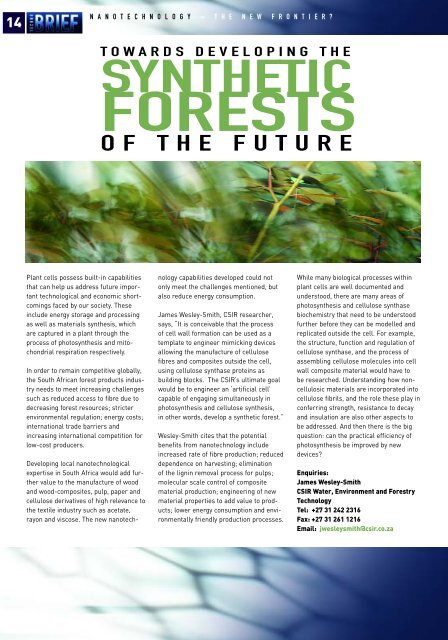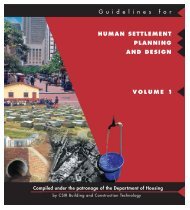14N A N O T E C H N O L O G Y – T H E N E W F R O N T I E R ?TOWARDS DEVELOPING THESYNTHETICFORESTSOF THE FUTUREPlant cells possess built-in capabilitiesthat can help us address future importanttechnological and economic shortcomingsfaced by our society. Theseinclude energy storage and processingas well as materials synthesis, whichare captured in a plant through theprocess of photosynthesis and mitochondrialrespiration respectively.In order to remain competitive globally,the South African forest products industryneeds to meet increasing challengessuch as reduced access to fibre due todecreasing forest resources; stricterenvironmental regulation; energy costs;international trade barriers andincreasing international competition forlow-cost producers.Developing local nanotechnologicalexpertise in South Africa would add furthervalue to the manufacture of woodand wood-composites, pulp, paper andcellulose derivatives of high relevance tothe textile industry such as acetate,rayon and viscose. The new nanotech-nology capabilities developed could notonly meet the challenges mentioned, butalso reduce energy consumption.James Wesley-Smith, <strong>CSIR</strong> researcher,says, “It is conceivable that the processof cell wall formation can be used as atemplate to engineer mimicking devicesallowing the manufacture of cellulosefibres and composites outside the cell,using cellulose synthase proteins asbuilding blocks. The <strong>CSIR</strong>’s ultimate goalwould be to engineer an ‘artificial cell’capable of engaging simultaneously inphotosynthesis and cellulose synthesis,in other words, develop a synthetic forest.”Wesley-Smith cites that the potentialbenefits from nanotechnology includeincreased rate of fibre production; reduceddependence on harvesting; eliminationof the lignin removal process for pulps;molecular scale control of compositematerial production; engineering of newmaterial properties to add value to products;lower energy consumption and environmentallyfriendly production processes.While many biological processes withinplant cells are well documented andunderstood, there are many areas ofphotosynthesis and cellulose synthasebiochemistry that need to be understoodfurther before they can be modelled andreplicated outside the cell. For example,the structure, function and regulation ofcellulose synthase, and the process ofassembling cellulose molecules into cellwall composite material would have tobe researched. Understanding how noncellulosicmaterials are incorporated intocellulose fibrils, and the role these play inconferring strength, resistance to decayand insulation are also other aspects tobe addressed. And then there is the bigquestion: can the practical efficiency ofphotosynthesis be improved by newdevices?Enquiries:James Wesley-Smith<strong>CSIR</strong> Water, Environment and ForestryTechnologyTel: +27 31 242 2316Fax: +27 31 261 1216Email: jwesleysmith@csir.co.za
15Wonder crop could pave the wayfor bio-fuel revolution“The price of petrol and dieselis going up!” This has become afamiliar announcement on theevening news. High oil prices dueto increased demand, tougherenvironmental requirements,uncertainties linked to terrorismand instability in the Middle Eastare some of the pressures thatare influencing the quest for alternative,cleaner forms of energy.Some would say that the bio-fuelrevolution has begun.Farming for energy is one avenuethat is being actively explored. Whileoffering a potential solution to theagricultural sector’s quest for ruralemployment and poverty alleviation,it could also fulfil the need forincreased use of renewable energyresources.In response to these trends, recentbusiness initiatives have proposedthe introduction of so-called “wonder-crop”exotic species for largescaleplanting and bio-diesel productionin South Africa. The motivesbehind these initiatives have beenthe laudable themes of ecologicalsustainability, poverty alleviation, jobcreation and business development.However, questions around thepotential hydrological, ecologicaland socio-economic effects of theassociated land-use changes remainunanswered due to a lack of information.The Land Use Hydrology group ofthe <strong>CSIR</strong> in Pietermaritzburg formspart of a team tasked by the WaterResearch Commission to conduct astudy into some of the impactsassociated with the large-scaleplanting of Jatropha curcas. The<strong>CSIR</strong>’s task is to conduct hydrologicalprocess studies of Jatrophawater use at selected sites inKwaZulu-Natal, using appropriatetechniques (site water balance andevapotranspiration measurements).This is to be followed by a modellingexercise wherein site-specific simulationsof water use will be verifiedagainst the measured data andextrapolated to a larger scale.Mark Gush, research scientist workingon this project, explains thatJatropha curcas was identified as anideal species to use for this studybecause it has been widely acceptedto be suitable for the production ofbio-diesel and secondary products.The prime ingredient in the manufactureof bio-diesel is vegetable oil(e.g. sunflower, soya or peanut oil),however, these oils are edible andgenerally fetch high prices, whichpreclude them from being used inbio-diesel production. Researchindicated that Jatropha curcasmerited serious consideration as aviable alternative.This small tree (of Central Americanorigin) is from the Euphorbiaceaefamily, and produces seeds containinghigh percentages (30-35%) of oil,which can be extracted easily forfurther processing (trans-esterificationinto bio-diesel) and refinement.The processed oil can then be usedin compression-ignition (diesel)engines after minor modifications.It can also be blended with conventionaldiesel to avoid the needfor engine modification. Theby-products of the bio-dieselprocessing plant are the nitrogenrichpress cake and glycerol, whichhave good commercial value asfertiliser and as a base for soap andcosmetics respectively. The leaves,roots and bark could also havepotential for numerous other industrialand pharmaceutical uses.Jatropha curcas grows readily inareas of low rainfall (less than250 mm per year) and in poor soils,allowing the potential use of lowfertility, marginal, degraded andotherwise unproductive lands. Thetrees are easy to establish (fromseeds or cuttings), grow relativelyquickly (producing seed after theirsecond year) and are hardy todrought, although they are relativelysensitive to frost.“The interest in this species hasheightened to a stage where therelevant national governmentdepartments (Agriculture, WaterAffairs and Forestry, EnvironmentalAffairs etc.) need to make a decisionas to whether or not to allow thelarge-scale propagation and commercialisationof this crop,” saysGush. “This project aims to contributeto the StrategicEnvironmental Assessment (SEA)proposed by the Department ofAgriculture to investigate the feasibility,viability and advisability of thewide-scale introduction of Jatrophacurcas to the KwaZulu-Natalprovince and South Africa as awhole.”Enquiries: Mark Gush<strong>CSIR</strong> Water, Environment andForestry TechnologyTel: +27 33 260 5783Fax: +27 33 260 5266Email: mgush@csir.co.za
















